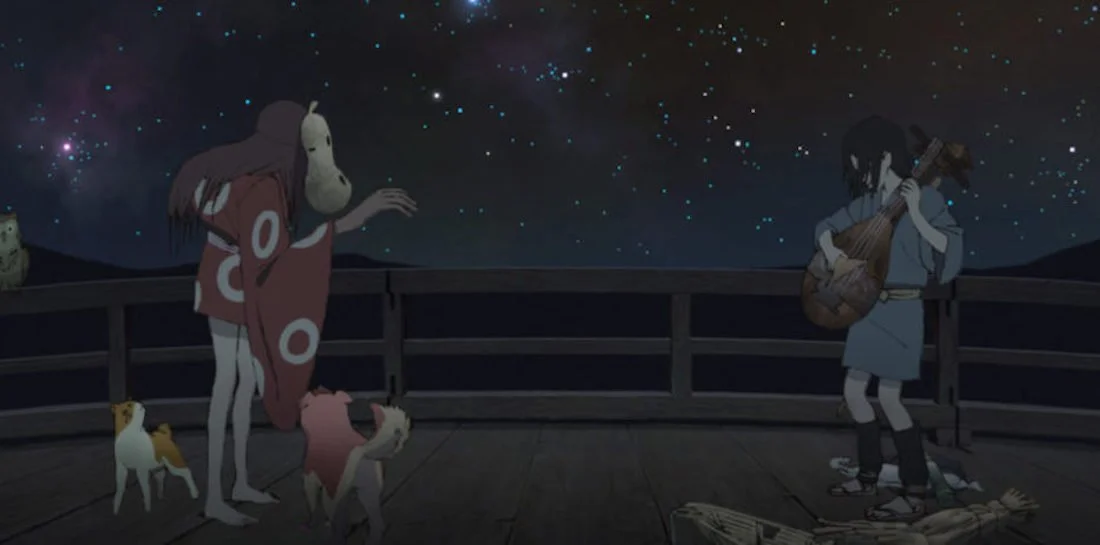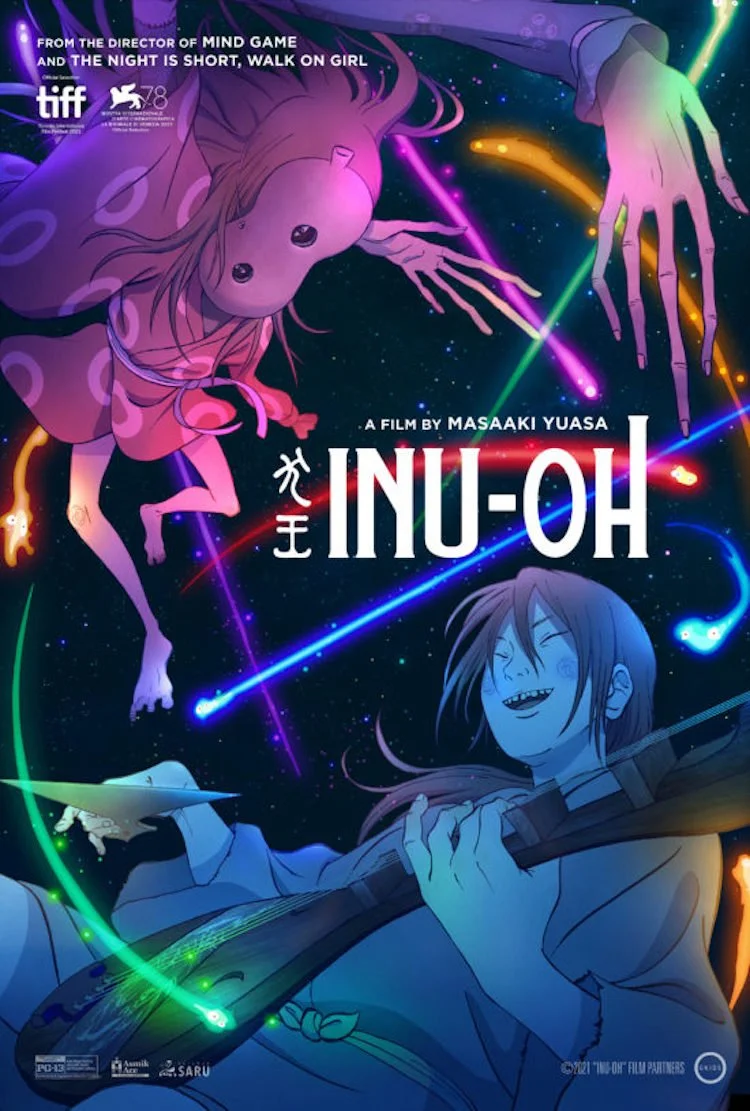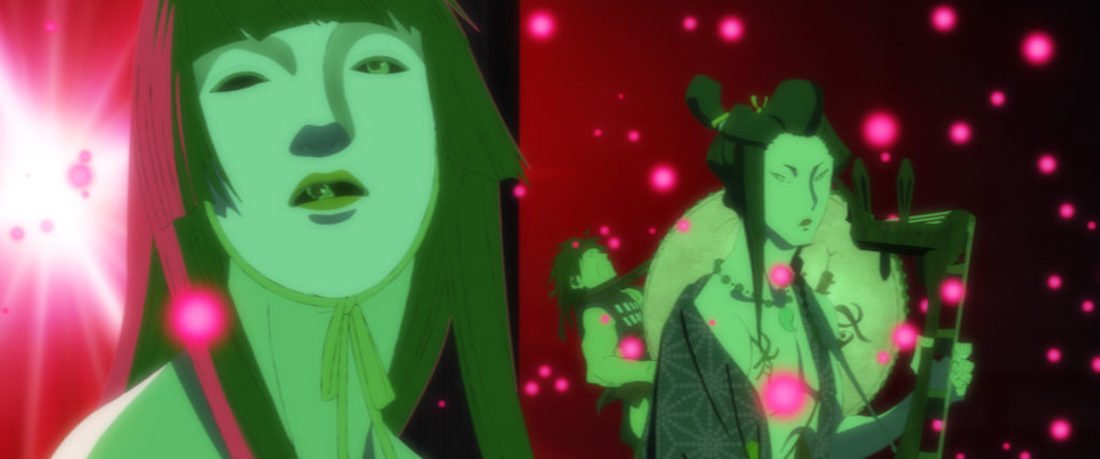Review: INU-OH (2022)
When it comes to immortality, we tend to think very literally about existing forever. There’s the usual neverending life of the corporeal self, found in works like HIGHLANDER, TWILIGHT, and Tuck Everlasting. Or it’s often framed in religious/supernatural terms of a soul persisting long past the body’s death, either stuck in ghost form or enjoy the eternal reward (or punishment) of some afterlife. But there’s a practical version of perpetual life that is often overlooked which is found in the legacy left behind. Every person—every person—has an effect on this world by causing some sort of change in others. Maybe they made that other person laugh, or introduced them to a new food, or listened when they were in pain, or insulted their clothes, or closed the door in their face; from the smallest gestures to the biggest actions, these moments reverberate and cause change throughout that person’s day, which in turn causes changes in other areas, and eventually the ripples reach out to the life as a whole. After you’re gone, you have still caused seismic differences in the world, even if you didn’t realize it.
Another practical form of immortality is what we create. It could be children, or music, or writing, or a treehouse, or whatever. That project can also carry forth well beyond your expiration date so people can revisit it, see it again, enjoy it anew. But what happens when that art is removed or those stories are forgotten? INU-OH, director Masaaki Yuasa’s latest film, looks at the marriage of the old and the new, as well as the power of continuing stories at a time when they could otherwise disappear. Gorgeously animated with terrific musical sequences, the movie’s anachronistic tale is bewitching as it deals with how all these acts echo through time. And while the ending stumbles due to poor set up of an underdeveloped theme, it’s still a terrific experience that is bewitching and inspiring.
In 14th century Japan, an attempt is underway for the Ashikaga Shogunate to unify the country and its various factions. The government hopes to do this through controlling narratives of the past, including the story of how the entire (massive) Heike clan was wiped out in a war three centuries earlier. Tomona, a young boy in a humble fishing village, is inadvertently blinded in this pursuit and loses his father. He sets off to avenge these acts and ends up becoming a biwa musician in a troupe of other blind artists. Meanwhile, a monstrosity (eventually named Inu-Oh) is born to a family of noh performers and dancers. He is promptly neglected for years, with a mask and rags to cover up his deformities while suffering abuse from his supposed loved ones.
Eventually these two young men meet and create an incredible spectacle that blends Tomona’s experimental music with Inu-Oh’s extravagant performances to tell the tales of the slain Heike clan that have otherwise been lost to time. Their sudden ascent to celebrity causes waves in society and the government, with fans enthralled by the artistic revolution while others worry about the destabilizing effects of this bold new vision of storytelling.
Written by Akiko Nogi (from Hideo Furukawa’s novel), INU-OH is a tremendously entertaining fusion of the current and the traditional.
Admittedly, it starts off with all of these disparate strands kind of meandering through time. There’s Tomona’s journey, then Inu-Oh’s existence, plus a ton of history lessons on the various wars that led up to this moment in time in Japan. There’s a ghost guide helping the young musician, the quest for ancient artifacts, establishing the social structure of the arts scenes in Kyoto, and much more. It’s a lot to take in, especially as it involves many characters who simply disappear after one scene and there are multiple jumps in time.
Luckily, Nogi’s script does its best to streamline these threads and Yuasa’s direction keeps it lively while smartly using imagery to tie all the plots together. Everything moves at a clip without feeling too rushed, culminating perfectly with the two characters meeting and forming their innovative partnership.
There are lots of great visual flourishes in INU-OH that, while not as experimental as Yuasa’s previous work (MIND GAME, WELCOME TO THE SPACE SHOW, THE NIGHT IS SHORT, WALK ON GIRL), remain a sumptuous feast for the eyes. The way that Tomona’s ability to “see” sounds is depicted beautifully, a nice mix of impressionist brush strokes, Daredevil radar, and that scene in RATATOUILLE where burst of colors describe how food tastes. Inu-Oh’s character design is singular but also feels akin to oddball characters found in Miyazaki’s films (particularly SPIRITED AWAY). But INU-OH shines brightest visually during the performances by the duo—and it they also happen to be the major highpoint of the entire movie.
These concerts are glam rock psychedelia at its finest. The music itself is terrific, combining the traditional sounds of biwa and taiko with modern touches of electric guitars and more. The music was written by composer Otomo Yoshihide, Yuasa, Yohei Matsui, and Inu-Oh’s voice actor Avu-chan, and is an exceptional blending of styles that is perfectly dramatic, extremely catchy, and wonderfully decadent. These songs are joined by brilliantly staged performances that combine the exquisite nature of classic noh with the extravagance of a raucous arena tour. INU-OH figures out a clever way to use period technology/techniques of the time to replicate contemporary aspects of modern musical stage shows (though obviously liberties are taken). With each event, the performers evolve and grow further into their own styles. While not comparable in subject matter, INU-OH conjured up how HEDWIG AND THE ANGRY INCH found that band slowly changing over time into becoming a more refined and exact version of themselves. In both cases the beautiful metamorphosis acts as a way of showing how the identities of the performers gains definition while still remaining painfully elusive.
While thoroughly engaging, the film staggers towards the finish line as new allegory is suddenly introduced that was never hinted at previously. This diverging path between characters is clearly meant as the conflict between an artist staying “pure” to their passion versus working within a system, but its lack of proper development simply makes it befuddling. There is also a coda about how this story fits into a larger context of Japanese history, but presented without much information on why certain names or impacts were important. These are ultimately minor problems, but it’s vital to stick the landing as that’s the note on which audiences are exiting. The rest of INU-OH is so strong with resplendent storytelling and imagery that it’s truly unfortunate that it can only meander towards the end.
Despite those flaws at the conclusion, the film is a tremendous ode to the vitality of storytelling and the ways it extends the lives of its subjects.
Immortality isn’t just found in the characters of the stories, but also in those telling the tales who do so in such an extravagant way that it changes the course of history and lives on with audiences forever.
INU-OH is just the latest example that Masaaki Yuasa is one of the premier filmmakers working today. His experimental approaches that blend animation techniques, tones, styles, and more create tremendous experiences for the viewers that excite and engage all of the senses. The movie is a great synthesis of the new and the old while telling a fun story with rich characters that work together to tackle larger issues. INU-OH joins Yuasa’s exceptional filmography to ensure that his own legacy will reverberate through the ages and his name will live on for a very, very long time.





